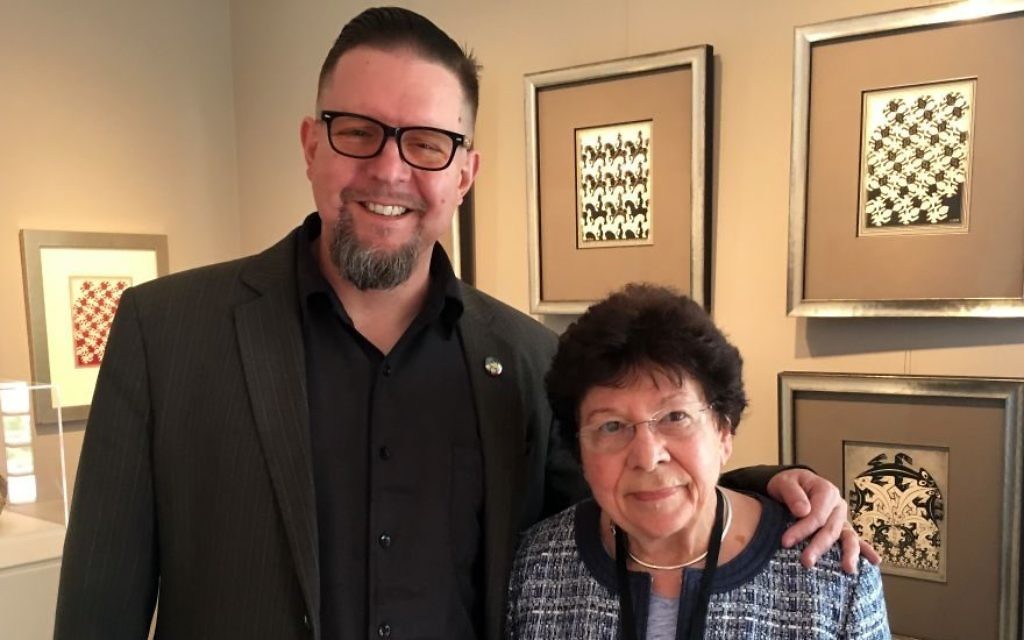Sephardic Mentor Guided Escher to Graphic Arts
Works by the Dutch artist, who lost his teacher to the Holocaust, are on display in Decatur.

A new exhibition of works by the late graphic artist M.C. Escher is showing through June 9 in Decatur at the Different Trains Gallery.
Born in the Netherlands in 1898, Escher produced more than 2,000 drawings and sketches during his lifetime, as well as hundreds of woodcuts, engravings and lithographs, many based on mathematical themes.
Though famous as a draftsman, muralist, illustrator and printmaker, Escher’s original intent was to be an architect.
Get The AJT Newsletter by email and never miss our top stories Free Sign Up
While a student from 1919 to 1922 in North Holland, Escher studied under a Sephardic Jew who became an important influence on him, changing the course of his life and career.
“Samuel Jessurun de Mesquita in his own right was a very fine graphic artist and taught at the School of Architecture and Decorative Arts in Haarlem, where Escher was enrolled,” said Doris Schattschneider, a former professor of mathematics at Moravian College and author of the book “M.C. Escher: Visions of Symmetry.”
“He convinced Escher to switch from architecture to graphic arts and taught him all the techniques of that and of printing,” she said by phone after attending the opening of the Different Trains exhibition.
The two men stayed in touch after college, but World War II changed everything.

“In 1944 Escher went up to visit de Mesquita in his studio (in Watergraafsmeer, reportedly to bring food to the family), and when he got there, the place had been trashed. His family and him had been taken by the Nazis to concentration camps and ultimately were killed. De Mesquita had refused to leave because he thought Sephardic Jews were not going to be targeted, but of course I don’t think the Nazis bothered to distinguish between different kinds of Jews,” Schattschneider said.
“Escher collected some of the loose graphic work of de Mesquita’s that was laying around on the floor, and one had a German footprint, a Nazi boot. He put them all in a folio and took a train back home. If he had been caught with them, it would have been the end of him, so he was really very brave, gathering what he could,” she said.
For the rest of his life, Escher kept the sketch with the German footprint pinned to a wall in his studio.
De Mesquita’s death affected Escher deeply, as did the war, and while not Jewish himself, “he was obviously very anti-Nazi” and nursed a grievance after being prevented from attending his mother’s funeral in The Hague because of the Dutch invasion by Nazi troops in May 1940.
He also gave shelter in his home to members of the Wertheim family, Jewish friends he had met in Rome. When the war ended, Escher took part in an exhibition of artists who had not acquiesced to the Reich Chamber of Culture, which had demanded an Aryan certificate when applying for membership. Artists who refused were banned from showing their work.
Escher also took it upon himself to promote the works of his dead teacher, de Mesquita, while staying under the radar, Schattschneider said. His true feelings about the war were made clear in some graphic prints he sent as New Year’s cards to friends but never published.
“This exhibit features 42 original prints and is the largest Escher show in Atlanta in over a decade,” said Shawn Vinson, the director of the Different Trains Gallery. “In addition, we have a confectionery tin designed by Escher in 1962, the first time it’s been displayed in public.”
He said the public reception to the exhibit “has been fantastic. People get excited, especially about the more iconic works, such as ‘Day and Night,’ which they’ve previously only seen in books and on posters, and are surprised as well to discover so many works they’d never known about before.”
What: M.C. Escher plus works by contemporary math artists
Where: Different Trains Gallery, 432 E. Howard Ave., No. 24, Decatur
When: 11 a.m. to 5 p.m. Thursday to Saturday and by appointment, through June 9
Admission: Free; www.differenttrainsgallery.com/mc-escher.html or 404-939-2787




comments